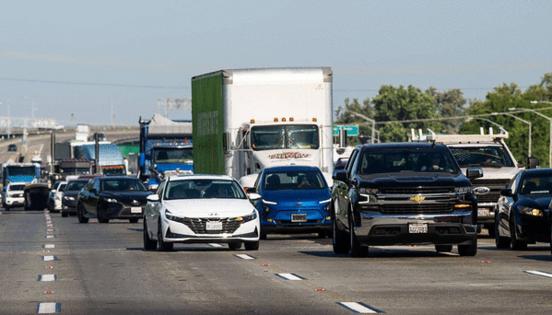California carbon emissions lag behind 2030 climate targets. Will new rules get us on track?
Published in Science & Technology News
SACRAMENTO, Calif. — California carbon emissions are falling, but not fast enough to reach the state’s 2030 climate targets, according to data released Friday by the Air Resources Board. Leaders predicted that new and existing industry regulations would put the state on track.
CARB Executive Officer Steven Cliff said in a media briefing that he anticipated the agency’s recent rules on clean cars and trucks will boost reductions in future years to keep pace with targets.
“We have a lot of policies on the books that are just starting to be binding, and that is why I would expect to see reductions accelerate,” said Cliff. “I never would have expected it would be a linear reduction, so I think it looks like we’re on track.”
According to the Air Board report on 2022 data, statewide carbon emissions fell that year by 9.3 million tons of carbon dioxide equivalent (MMTCO2e). CARB is still processing last year’s data.
Most of the reductions came from the transportation sector, aided by increased EV adoption and growth of biofuels. Electricity sector emissions declined despite an increase in overall production, driven by deployment of renewable energy sources.
The agency also reported drops in industrial, agricultural and landfill carbon pollution, though commercial and residential buildings saw an increase.
According to CARB’s report, emissions are falling below the pace required to reach the state’s 2030 climate targets. Those include one set by lawmakers in 2016 and another more ambitious goal set by the agency in its 2022 climate adaptation roadmap, or scoping plan.
To reach either 2030 target, California carbon emissions would need to fall each year by 13.6 and 17.2 MMTCO2e per year, respectively.
That would be equivalent to taking either three or four million cars off the road every year. But CARB’s latest report found emissions cuts in 2022 were equivalent to removing roughly two million cars.
As part of its efforts to combat climate change and lead the nation in environmental policy, California established overarching targets to reducing carbon emissions across its economy.
Nearly 20 years ago, the state legislature passed the Global Warming Solutions Act, Assembly Bill 32, which aimed to reduce state emissions to 1990 levels by 2020. This established 1990 emissions—equivalent to 427 million metric tons of CO2—as a permanent baseline.
After achieving that goal ahead of schedule, lawmakers set a new target in 2016 to cut emissions 40% below the baseline by 2030.
Then in 2022, the California Air Resources Board (CARB) announced a more ambitious target in its scoping plan, aiming for a 48% reduction by the same year.
Climate policy experts have warned that California, while ambitious in setting targets, is not taking sufficient steps to meet them. CARB has faced criticism for lacking a clear implementation strategy of its climate plan and relying on optimistic assumptions.
Last year, Air Board staff indicated that the state may not reach its more ambitious scoping plan target. The agency placed heavy bets on emerging technologies such as carbon capture and carbon removal to remove carbon pollution from the atmosphere.
Those technologies, agency staff acknowledged, may not be widely available in time. They said tightening California’s primary carbon pricing framework, called cap-and-trade, to reach the target instead could push polluters out of the state.
The Air Board has adopted several major climate regulations in recent years aimed at significantly reducing carbon emissions, including clean car rules passed in 2020 and a framework for trucks in 2021.
The cars rule only went into effect starting in 2022. The clean trucks rule is currently postponed until the agency receives a waiver from the Environmental Protection Agency.
On the board’s upcoming agenda are updates to two other major climate policies: the Low Carbon Fuel Standard (LCFS), which sets carbon intensity reduction targets for transportation fuels, and Cap and Trade, the market-based system capping overall emissions.
The LCFS has been the subject of significant criticism, including from lawmakers after a policy update was estimated to raise gas prices and from climate advocates who argue that the program’s biofuel subsidies overstate climate benefits.
A revised version of the LCFS is set for a board vote in November 8.
____
©2024 The Sacramento Bee. Visit at sacbee.com. Distributed by Tribune Content Agency, LLC.







Comments